Scientific Area
Abstract Detail
Nº613/2130 - Plant defense against herbivores of native and non-native populations of Datura stramonium
Format: ORAL
Authors
Juan Nez-Farfn1, Juan Arroyo2
Affiliations
1 Instituto de Ecología, Universidad Nacional Autónoma de México, México.
2 Departmento de Biología Vegetal y Ecología, Universidad de Sevilla, España.
Abstract
Plant defense against herbivores of native and non-native populations of Datura stramonium
Datura stramonium has successfully established in many regions worldwide from its native range in America. Historical accounts indicated that it was introduced to Europe (Spain) after the conquest of Mexico. In the introduced range D. stramonium lacks the biotic interactions maintained in its native range opening the opportunity to further evolution. Here, we present field and experimental evidence on changes in plant defense hypothetically promoted by the difference in specialist herbivores between ranges. Results indicate that damage exerted by specialist and generalist herbivores on native and non-native plants differ; specialist herbivores preferred the native plants. There are differences between populations, of both ranges, in resistance to herbivores. The tropane alkaloid scopolamine has a higher concentration on a native population whereas the alkaloid atropine is higher in a non-native population. Analysis of volatile compound emitted by D. stramonium, showed that native plants produce a greater number of volatile compounds than non-native plants. Expression of gene TPS10, involved in the synthesis of volatile compounds, is higher in artificially damaged plants relative to control plants, and higher in native population and non-native populations. Overall, results suggest quantitative and qualitative change in defense traits between non-native population of D. stramonium but most changes are at the population level.




